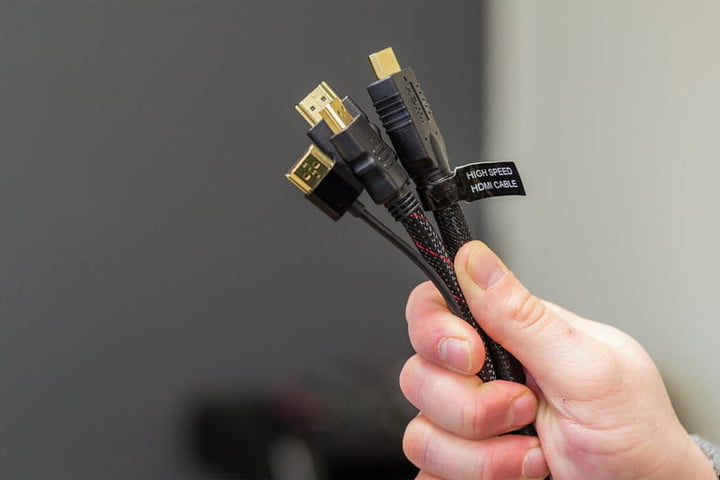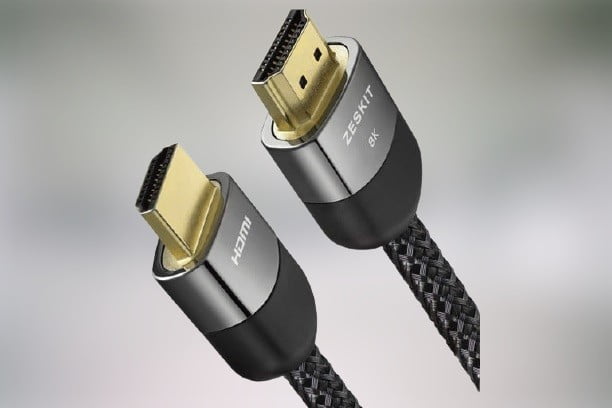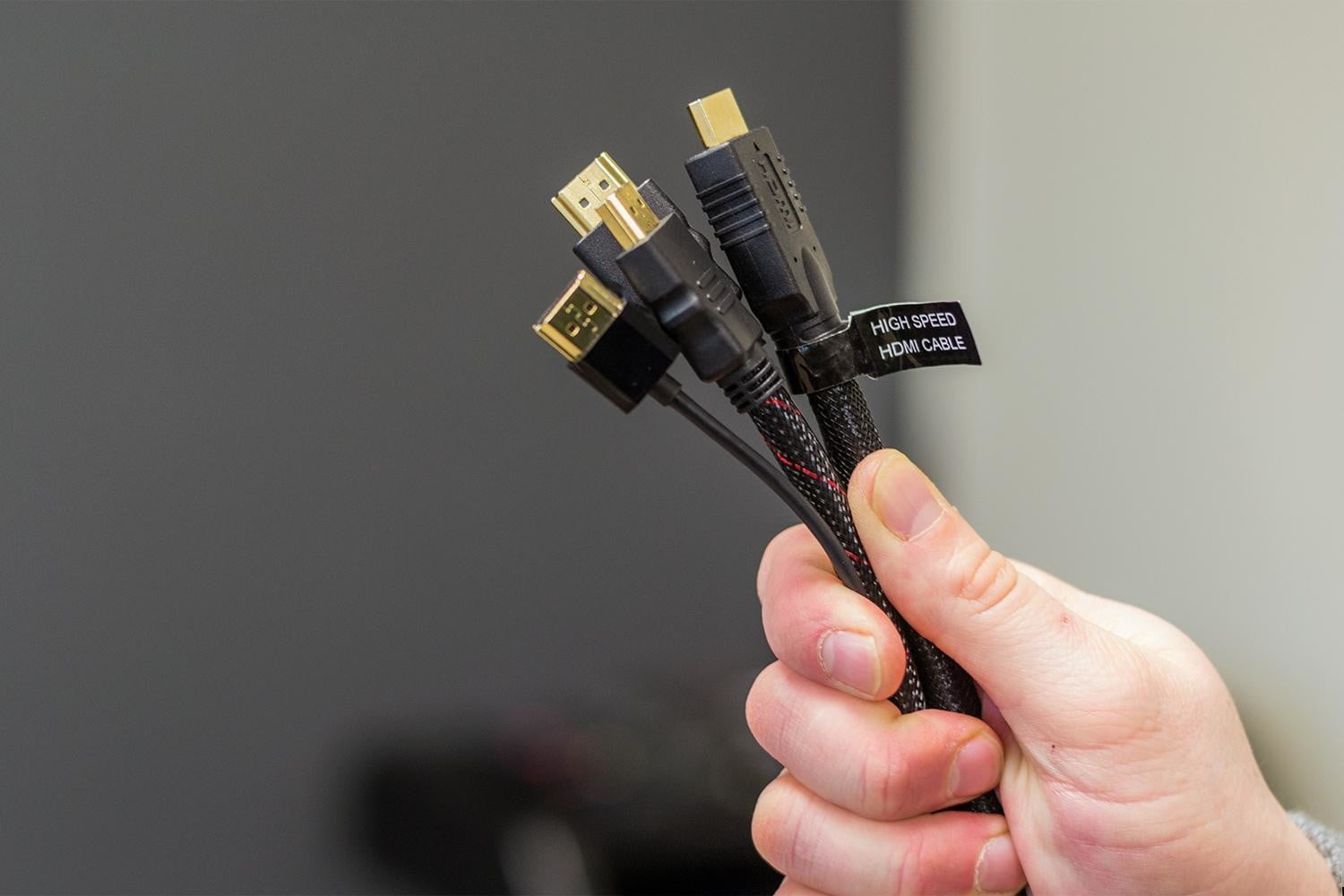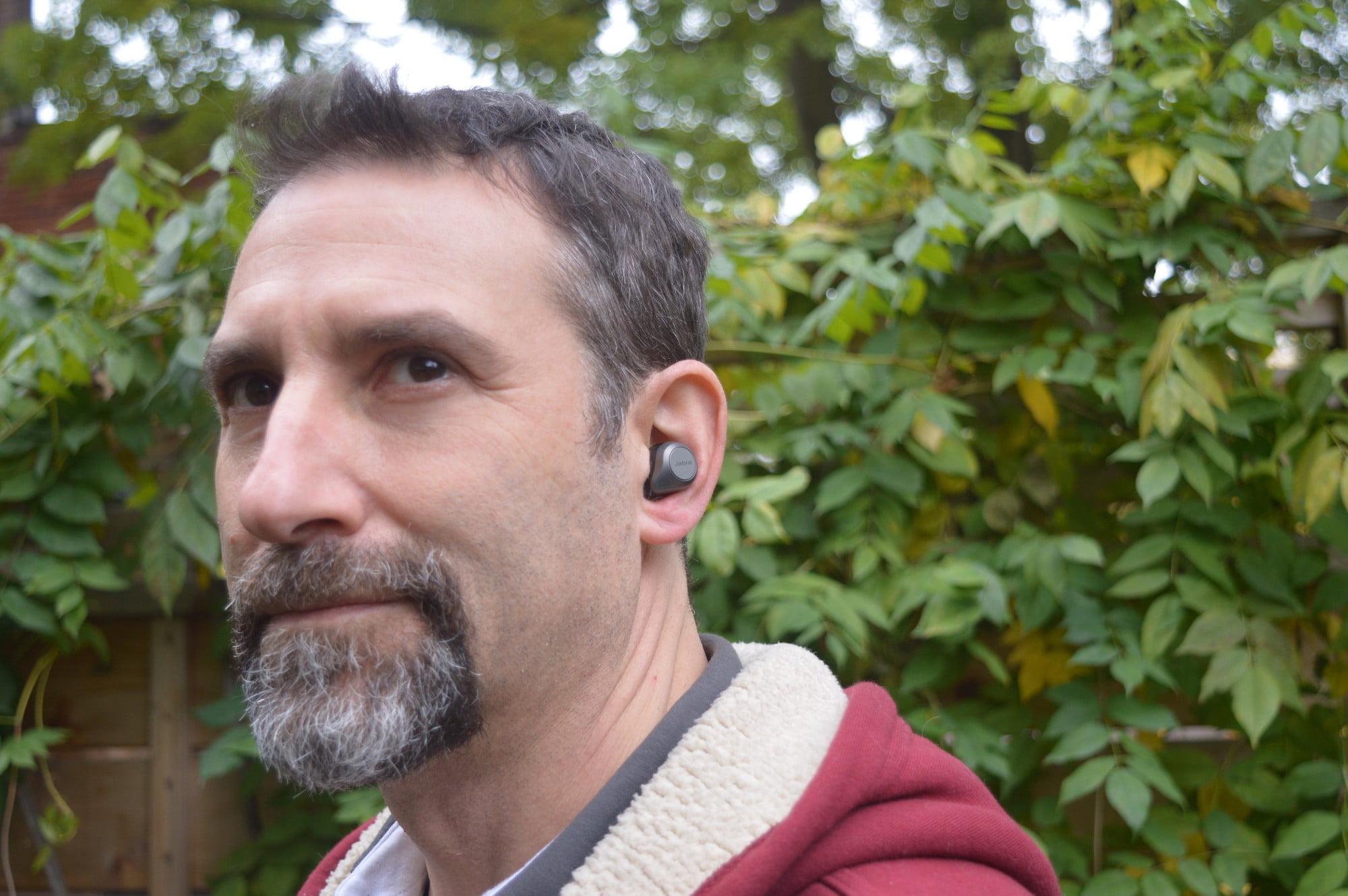Thanks to HDMI, long gone are the days of requiring a rat’s nest of wires to connect all of your treasured A/V equipment to your TV, projector, or other display. Consolidating audio and video signals into a single cable run, HDMI wires and ports are the new standards for even the most modest of home theater setups, and with many households owning everything from game systems and Blu-ray players to cable boxes, chances are you are going to require more than one.
But when shopping for an individual HDMI cable or several, what exactly should you be looking for? With criteria like bandwidth, resolution, and cable jacketing to consider, purchasing an HDMI may not sound so simple — but rest assured, we’re here to help.
To help you better understand the world of HDMI, we’ve put together this guide that covers the many details of the connection and have provided a number of our own recommendations for when you’re ready to shop.
At a glance
How to pick the best HDMI cable

Despite efforts on the part of some manufacturers to label their cables as HDMI 2.0 or HDMI 2.1, what differentiates one HDMI cord from another isn’t the HDMI version. That version number (1, 1.4, 2.0, 2.1, etc.) describes the capabilities of your hardware — from OLED TVs and soundbars to A/V receivers, etc. — not your HDMI cables.
That said, there is a relationship between the version of HDMI your devices use and the kind of HDMI cable you should buy.
Speed (or bandwidth)
Speed is the single biggest consideration when choosing an HDMI cable because if your cable isn’t fast enough for your specific equipment, HDMI version, and media sources, it won’t be reliable.
HDMI cable speed is measured in gigabits per second (Gbps); don’t worry, you don’t need to memorize a bunch of numbers. To keep things simple, HDMI.org — the group that maintains the specifications for both HDMI device and HDMI cables — sorts HDMI cable speed into four main categories:
If you don’t own a 4K UHD TV and you don’t plan on buying one any time soon, a standard HDMI cable is probably all you need. It supports HD video in both 720p and 1080i resolutions. We’ve seen 1080p work with standard HDMI cables, but it’s not guaranteed. You can use these regular HDMI cables with DVD players, Blu-ray players, game consoles, streaming media players, and even A/V receivers and soundbars. Just keep in mind, if you ever decide to venture beyond the realm of HD, you may need something faster.
This is the A/V world’s workhorse. High Speed HDMI cables can manage any device or content all the way up to video with 4K resolution at 30Hz. 3D video, deep color, and, of course, 1080p HD are all supported. Static HDR (like HDR10) will work, too, although we don’t recommend this kind of cable if you want to experience Dolby Vision HDR. As a dynamic version of HDR, it uses a lot more data and thus benefits from a faster cable.
As long as you’re sticking to the world of 4K UHD, and you don’t anticipate wanting to use bleeding-edge features like 8K or eARC, a Premium High Speed HDMI cable is going to last you for a very long time. It’s guaranteed to offer 18Gbps, which is what HDMI 2.0b devices need to perform at their best. This premium HDMI cable can support 4K resolution up to 60Hz, all flavors of HDR, including Dolby Vision and HDR10+, and audio return channel (ARC) so that you can simplify your cabling to your TV with just a single connection.
If you bought your TV or any other piece of A/V equipment in the last two or three years, Premium High Speed is the way to go.
Welcome to the top of the HDMI tower. Ultra High Speed HDMI is for people who want the ultimate in future-proofing. Representing the bleeding-edge of HDMI tech, ultra-certified cables are guaranteed to provide the full 48Gbps that enables all of the advanced features in the HDMI 2.1 specification, including 8K/60Hz and 4K/120Hz video, eARC, all versions of HDR, and the many varieties of variable refresh rate (VRR) technologies.
Do you need this kind of cable? At the moment, only two categories of folks can really benefit from it: Next-gen gamers on consoles like the PS5 or Xbox Series X, both of which support gaming in 4K/120Hz and 8K/60Hz, and those who own 8K TVs. Keep in mind, to be able to game at 4K/120Hz or 8K/60Hz, your TV needs to support these resolutions and frame rates, too.
Cable length
In an ideal world, you’d pick the HDMI cable that had the shortest possible length for your desired components. Setups have a habit of changing as you add, remove, and relocate your A/V gear, so make sure you select an HDMI cable that is long enough for your current and future needs, especially if you’re installing it in a wall or ceiling.
But be wary of any HDMI cable that runs longer than 25 feet. These super-long cables can suffer from signal degradation, and you might find that long cables do not maintain a reliable connection between your devices, and don’t even think of connecting several together with an HDMI adapter, that won’t work either. Always check to make sure an HDMI cable works with all of your devices, HDMI switch, HDMI splitter, and content types before installing it permanently. An active HDMI cable uses a small chip to borrow a tiny bit of power from the devices they’re connected to, which helps maintain signal strength over longer distances.
When considering longer cable runs, cable quality becomes much more important. Read customer and pro reviews carefully before you buy a long cable and make sure the manufacturer has a good warranty.
Installation type — it matters
If you’re planning on running an HDMI cable through a wall or ceiling, it must be rated for that type of use. Do not run a standard HDMI cable behind drywall; its protective covering has not been designed to withstand accidental contact with construction materials like nails, screws, and metal drywall hangers. Look for cables with a CL2 or CL3 rating, and always check your local building codes for compliance before installing. Installing an HDMI cable in a wall isn’t always a great idea, even if the cable is rated for in-wall use. Check out our HDMI alternatives section below for other ways to run an A/V signal through walls or over long distances.
The best all-around Ultra High Speed HDMI cable: SecurOMax High-Speed 4K HDMI Cable
Whether you’re rocking your gaming setup on or watching a ton of 4K content on your OLED TV, if you’re looking for a high-powered, heavy-duty HDMI cable that you can set and forget, SecurOMax makes a mean cord. While it’s not an 8K cable, that’s OK, this high-speed HDMI cable supports 4K UHD, Ultra HD 2160p, Quad HD 1440p, Full HD 1080p, and 3D, delivering high performance and low interference when connected to your hardware.
This cotton braided cable was built to last and includes oxygen-free bare copper wiring and is triple-shielded for maximum performance and ultra-low signal-to-noise ratio (SNR). The SecurOMax is a 24K gold-plated connector with soldering points covered by a thick aluminum shell, meaning it’s durable and built to last.
The SecurOMax HDMI is tangle-free and super-flexible, as well as being conveniently integrated with ethernet and ARC. Plus, this cable is offered at 15-foot and 25-foot lengths, giving more flexibility to your gaming or home theater setups. And with a price ranging from $10 to $25, you really can’t go wrong.
The best certified HDMI cable: Monoprice Certified Premium High Speed HDMI Cable
What’s the difference between a certified and a non-certified HDMI cable? Not much. If an HDMI cable is truly a high-speed cable, it will perform all of the needed duties like transmitting 4K/60Hz, high dynamic range (HDR), and 4:4:4 deep-color video, plus uncompressed audio.
The difference is that a certified cable has been independently tested to meet HDMI.org’s “ultra reliability” criteria. We’re of the opinion that an HDMI cable either works or does not, but for some people, the added peace of mind that comes with a certification of reliability is worth a few extra dollars.
Available in sizes from 3 to 30 feet and starting at less than $10, this Monoprice Certified Premium High Speed HDMI cable is the least expensive HDMI cable that’s certified we could find, and like all Monoprice cables, it carries a lifetime warranty.
The best non-certified HDMI cable: AmazonBasics High-Speed 4K HDMI Cable
All high-speed HDMI cables can easily support 4K UHD video, and as the name suggests, this cheap HDMI cable is one of the most reliable ways to connect your HDMI devices.
Available in sizes from 3 to 100 feet and starting at less than $10, these cables are affordably priced and backed by Amazon’s lifetime warranty.
Curiously, AmazonBasics High-Speed 4K HDMI Cables are often the same price as the Monoprice Certified Premium High Speed HDMI Cable, so which one you choose may simply come down to considerations like shipping fees — Amazon Prime members get free shipping on this cable, while Monoprice.com charges a small fee for shipping.
The best Ultra High Speed HDMI cable for 8K and next-gen gaming: Zeskit 8K Ultra HD High Speed 48Gpbs HDMI Cable

For the very best HDMI performance, a cable that is rated for 48Gbps is ideal. There are several of these on the market, like the Monoprice DynamicView.
But if you want the extra peace of mind that comes with HDMI.org’s certification, the is currently one of the few that has earned that designation. Better yet, Zeskit offers it in four lengths: 3 feet, 6.5 feet, 10 feet, and 16 feet, and none of these sizes are especially expensive.
The 6.5-feet version is $20. We’d prefer it if Zeskit offered a lifetime warranty on its cables as Monoprice does, but the company’s two-year warranty is likely long enough that if there’s a problem, you’ll find it long before the warranty period has expired.
The best for connecting portable video devices: BlueRigger4K Micro HDMI to HDMI
If you ever have the need to connect other photo or video devices besides your smartphone (you mean there are other devices?) directly to your TV or monitor for quick viewing, then the BlueRigger Micro HDMI to HDMI cable is the way to go.
GoPro cameras, digital cameras, video cameras, and even some tablets and smartphones can be connected from their Micro HDMI ports to send 4K data at 60Hz at up to 18Gbps speeds to TVs, computer monitors, and projectors. And while it’s not 8K capable, you’re probably not going to need that quite yet, unless you have 8K content ready to be viewed on your 8K TV.
BlueRigger is known for its durable and rugged cables, and this Micro HDMI to HDMI cable is a case in point. Gold-plated connectors and shielded premium 32-gauge cable are tough but still flexible enough to easily route through any messy cable rat’s nest. Available in 3- to 15-foot lengths, there’s a perfect length for your situation, and BlueRigger’s limited lifetime warranty is a nice-to-have perk.
Honorable mention: Mediabridge High-Speed 4K HDMI Cable
AmazonBasics has some high-quality HDMI cables, but if you’re looking for an alternative that lands in the same price range and offers similar length options — 3 to 50 feet — then it’s hard to find a flaw in the MediaBridge High-Speed HDMI cable.
This cable features added thickness and durability, with reinforced molded ends, pure copper conductors, triple shielding, and gold-plated connectors, adding to an incredible sound and picture quality experience.
The Mediabridge HDMI cable can handle pretty much everything you can throw at it, including support for HDMI 2.0b and 18Gbps transfer speeds, 3D, ARC, HDR video with 48-bit deep color, and has an integrated Ethernet for convenience.
Plus, it supports all refresh rates from 30hz to 240Hz for fast gaming and watching action sports and gaming. It’s also backed by a lifetime warranty, so have at it.
Will high-speed HDMI cables always work?
In the past, most experts would have said that either an HDMI cable works or it doesn’t. Heck, we said that earlier in this article. Unlike analog cables, where the signal quality can degrade from excellent to poor and have a corresponding effect on video or audio, HDMI is a digital cable — and ones and zeroes don’t have quality. They either make it from the source device (like a Blu-ray player) to the destination device (a TV), or they do not. Occasionally, if there is a problem with the signal path (usually caused by a cable run that’s too long), you’ll see “sparkles” on the TV screen. This means that some of the ones and zeroes aren’t making it across the gap. The solution is almost always to replace your HDMI cable with a shorter one.
However, new technologies like Dolby Vision and HDR10+ use far more bandwidth than even HDR10. Known generically as dynamic HDR, these formats can be very picky about HDMI cable transmission speed. For instance, when you enable Dolby Vision for the first time on an Apple TV 4K, it will test the speed of the HDMI connection to your Dolby Vision-compatible 4K HDR TV. If the speed isn’t sufficient, you won’t be able to use Dolby Vision, and the Apple TV will revert to HDR10 for HDR content. We’ve found that even when using a high-speed cable that passes this speed test, there can still be times when the Dolby Vision connection drops out, resulting in a black screen.
Because of this, we strongly recommend that if you have Dolby Vision or HDR10+ A/V equipment, you only buy high-speed HDMI cables that are guaranteed to deliver the full 18Gbps, and that you test them thoroughly with Dolby Vision or HDR10+ content before installing them more permanently.
Likewise, if you own or plan to own a next-gen gaming console, an ultra-high-speed HDMI cable is essential if you want to be able to exploit all of the capabilities of your console.
HDMI cable alternatives
Run a cable conduit
Running an HDMI cable through a wall over a short distance of 10 feet or less is usually no problem, as long as the HDMI cable is CL-rated. But this setup isn’t ideal, even using a cable intended for in-wall use. For one thing, they’re difficult or impossible to repair if damaged, making them a problematic choice for in-wall use, according to Jeff Napoleone of Cloud 9 AV in Toronto. Napoleone recommends installing a cable conduit behind the wall if you’re sticking with HDMI. That makes it easier to run the cable and also offers additional protection.
HDMI-over-Ethernet
If you’re going to need a cable that spans extended distances, your best bet is to purchase an HDMI-over-Ethernet extender. The system uses a standard Cat5 or Cat6 networking cable, which is easier to wire through walls and much easier to repair than a damaged HDMI cable. It is worth noting that despite an earnest search on our part, there are currently no HDMI-over-Ethernet extenders with a viable connection for the complete HDMI 2.1 feature.
Network cable
Networking cable can be a much more cost-efficient option than HDMI, especially if you have a long-distance to span. You pay for networking cable by the foot, and each foot costs a nickel at most, so even if it adds up, it can still be very long without breaking the bank. Another benefit is the ability to swap out the transmitter and receiver for newer devices as technology improves, without having to rewire.
Wireless HDMI
While they’ve been around for more than a decade, wireless HDMI hasn’t really taken off, mostly due to the lack of standards in the industry and questions about their ability to handle latency — or a lag in the signal being transferred from your component/source to your TV. That said, if you don’t want to deal with the messy nest of cables behind your media center, or have some distance you just can’t cover with cables, they are relatively simple to set up (a transmitter plugs into the HDMI port of your component and a receiver into your TV’s HDMI port) and might be the solution for you.


